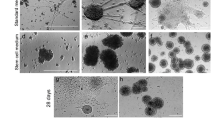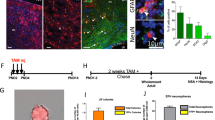Abstract
Neural stem (NS) cells are a self-renewing population of symmetrically dividing multipotent radial glia-like stem cells, characterized by homogeneous expansion in monolayer. Here we report that fetal NS cells isolated from different regions of the developing mouse nervous system behave in a similar manner with respect to self-renewal and neuropotency, but exhibit distinct positional identities. For example, NS cells from the neocortex maintain the expression of anterior transcription factors, including Otx2 and Foxg1, while Hoxb4 and Hoxb9 are uniquely found in spinal cord-derived NS cells. This molecular signature was stable for over 20 passages and was strictly linked to the developmental stage of the donor, because only NS cells derived from E14.5 cortex, and not those derived from E12.5 cortex, carried a consistent transcription factor profile. We also showed that traits of this positional code are maintained during neuronal differentiation, leading to the generation of electrophysiologically active neurons, even if they do not acquire a complete neurochemical identity.






Similar content being viewed by others
Abbreviations
- BDNF:
-
Brain-derived neurotrophic factor
- CNS:
-
Central nervous system
- D-V:
-
Dorsoventral
- EGF:
-
Epidermal growth factor
- ESC:
-
Embryonic stem cell
- FGF-2:
-
Fibroblast growth factor 2
- GABA:
-
γ-Aminobutyric acid
- GAP-43:
-
Growth-associated protein 43
- GFAP:
-
Glial fibrillary acid protein
- LGE:
-
Lateral ganglionic eminence
- MAP2:
-
Microtubule-associated protein 2
- MGE:
-
Medial ganglionic eminence
- MN:
-
Motorneuron
- NS cells:
-
Radial glia-like neural stem cells
- R-C:
-
Rostrocaudal
- Shh:
-
Sonic hedgehog
- SVZ:
-
Subventricular zone
References
Wolpert L (1969) Positional information and the spatial pattern of cellular differentiation. J Theor Biol 25:1–47
Lupo G, Harris WA, Lewis KE (2006) Mechanisms of ventral patterning in the vertebrate nervous system. Nat Rev Neurosci 7:103–114
Krumlauf R (1993) Hox genes and pattern formation in the branchial region of the vertebrate head. Trends Genet 9:106–112
Wassef M, Joyner AL (1997) Early mesencephalon/metencephalon patterning and development of the cerebellum. Perspect Dev Neurobiol 5:3–16
Rubenstein JL, Beachy PA (1998) Patterning of the embryonic forebrain. Curr Opin Neurobiol 8:18–26
McMahon AP (2000) Neural patterning: the role of Nkx genes in the ventral spinal cord. Genes Dev 14:2261–2264
Campbell K (2003) Dorsal-ventral patterning in the mammalian telencephalon. Curr Opin Neurobiol 13:50–56
Conti L, Pollard SM, Gorba T, Reitano E, Toselli M, Biella G, Sun Y, Sanzone S, Ying QL, Cattaneo E, Smith A (2005) Niche-independent symmetrical self-renewal of a mammalian tissue stem cell. PLoS Biol 3:e283
Pollard SM, Conti L, Sun Y, Goffredo D, Smith A (2006) Adherent neural stem (NS) cells from fetal and adult forebrain. Cereb Cortex 16(Suppl 1):i112–i120
Glaser T, Pollard SM, Smith A, Brustle O (2007) Tripotential differentiation of adherently expandable neural stem (NS) cells. PLoS One 2:e298
Goffredo D, Conti L, Di Febo F, Biella G, Tosoni A, Vago G, Biunno I, Moiana A, Bolognini D, Toselli M, Cattaneo E (2008) Setting the conditions for efficient, robust and reproducible generation of functionally active neurons from adult subventricular zone-derived neural stem cells. Cell Death Differ 15:1847–1856
Onorati M, Camnasio S, Binetti M, Jung CB, Moretti A, Cattaneo E (2010) Neuropotent self-renewing neural stem (NS) cells derived from mouse induced pluripotent stem (iPS) cells. Mol Cell Neurosci 43:287–295
Kim JB, Zaehres H, Arauzo-Bravo MJ, Scholer HR (2009) Generation of induced pluripotent stem cells from neural stem cells. Nat Protoc 4:1464–1470
Koch P, Opitz T, Steinbeck JA, Ladewig J, Brustle O (2009) A rosette-type, self-renewing human ES cell-derived neural stem cell with potential for in vitro instruction and synaptic integration. Proc Natl Acad Sci U S A 106:3225–3230
Hitoshi S, Tropepe V, Ekker M, van der Kooy D (2002) Neural stem cell lineages are regionally specified, but not committed, within distinct compartments of the developing brain. Development 129:233–244
Santa-Olalla J, Baizabal JM, Fregoso M, del Carmen Cardenas M, Covarrubias L (2003) The in vivo positional identity gene expression code is not preserved in neural stem cells grown in culture. Eur J Neurosci 18:1073–1084
Zappone MV, Galli R, Catena R, Meani N, De Biasi S, Mattei E, Tiveron C, Vescovi AL, Lovell-Badge R, Ottolenghi S, Nicolis SK (2000) Sox2 regulatory sequences direct expression of a (beta)-geo transgene to telencephalic neural stem cells and precursors of the mouse embryo, revealing regionalization of gene expression in CNS stem cells. Development 127:2367–2382
Hack MA, Sugimori M, Lundberg C, Nakafuku M, Gotz M (2004) Regionalization and fate specification in neurospheres: the role of Olig2 and Pax6. Mol Cell Neurosci 25:664–678
Gabay L, Lowell S, Rubin LL, Anderson DJ (2003) Deregulation of dorsoventral patterning by FGF confers trilineage differentiation capacity on CNS stem cells in vitro. Neuron 40:485–499
Bithell A, Finch SE, Hornby MF, Williams BP (2008) Fibroblast growth factor 2 maintains the neurogenic capacity of embryonic neural progenitor cells in vitro but changes their neuronal subtype specification. Stem Cells 26:1565–1574
Okabe M, Ikawa M, Kominami K, Nakanishi T, Nishimune Y (1997) ‘Green mice’ as a source of ubiquitous green cells. FEBS Lett 407:313–319
Spiliotopoulos D, Goffredo D, Conti L, Di Febo F, Biella G, Toselli M, Cattaneo E (2009) An optimized experimental strategy for efficient conversion of embryonic stem (ES)-derived mouse neural stem (NS) cells into a nearly homogeneous mature neuronal population. Neurobiol Dis 34:320–331
Doetsch F, Garcia-Verdugo JM, Alvarez-Buylla A (1997) Cellular composition and three-dimensional organization of the subventricular germinal zone in the adult mammalian brain. J Neurosci 17:5046–5061
Bertrand N, Castro DS, Guillemot F (2002) Proneural genes and the specification of neural cell types. Nat Rev Neurosci 3:517–530
Selkoe D, Kopan R (2003) Notch and Presenilin: regulated intramembrane proteolysis links development and degeneration. Annu Rev Neurosci 26:565–597
Tao W, Lai E (1992) Telencephalon-restricted expression of BF-1, a new member of the HNF-3/fork head gene family, in the developing rat brain. Neuron 8:957–966
Monaghan AP, Grau E, Bock D, Schutz G (1995) The mouse homolog of the orphan nuclear receptor tailless is expressed in the developing forebrain. Development 121:839–853
Shi Y, Chichung Lie D, Taupin P, Nakashima K, Ray J, Yu RT, Gage FH, Evans RM (2004) Expression and function of orphan nuclear receptor TLX in adult neural stem cells. Nature 427:78–83
Britz O, Mattar P, Nguyen L, Langevin LM, Zimmer C, Alam S, Guillemot F, Schuurmans C (2006) A role for proneural genes in the maturation of cortical progenitor cells. Cereb Cortex 16(Suppl 1):i138–i151
Laeng P, Pitts RL, Lemire AL, Drabik CE, Weiner A, Tang H, Thyagarajan R, Mallon BS, Altar CA (2004) The mood stabilizer valproic acid stimulates GABA neurogenesis from rat forebrain stem cells. J Neurochem 91:238–251
Aubry L, Bugi A, Lefort N, Rousseau F, Peschanski M, Perrier AL (2008) Striatal progenitors derived from human ES cells mature into DARPP32 neurons in vitro and in quinolinic acid-lesioned rats. Proc Natl Acad Sci U S A 105:16707–16712
Stenman JM, Wang B, Campbell K (2003) Tlx controls proliferation and patterning of lateral telencephalic progenitor domains. J Neurosci 23:10568–10576
Wichterle H, Lieberam I, Porter JA, Jessell TM (2002) Directed differentiation of embryonic stem cells into motor neurons. Cell 110:385–397
Stone D, Rosenthal A (2000) Achieving neuronal patterning by repression. Nat Neurosci 3:967–969
Ericson J, Briscoe J, Rashbass P, van Heyningen V, Jessell TM (1997) Graded sonic hedgehog signaling and the specification of cell fate in the ventral neural tube. Cold Spring Harb Symp Quant Biol 62:451–466
Sander M, Sussel L, Conners J, Scheel D, Kalamaras J, Dela Cruz F, Schwitzgebel V, Hayes-Jordan A, German M (2000) Homeobox gene Nkx6.1 lies downstream of Nkx2.2 in the major pathway of beta-cell formation in the pancreas. Development 127:5533–5540
Jacob J, Briscoe J (2003) Gli proteins and the control of spinal-cord patterning. EMBO Rep 4:761–765
Kessaris N, Pringle N, Richardson WD (2001) Ventral neurogenesis and the neuron-glial switch. Neuron 31:677–680
Ariano MA, Cepeda C, Calvert CR, Flores-Hernandez J, Hernandez-Echeagaray E, Klapstein GJ, Chandler SH, Aronin N, DiFiglia M, Levine MS (2005) Striatal potassium channel dysfunction in Huntington’s disease transgenic mice. J Neurophysiol 93:2565–2574
Gaspard N, Gaillard A, Vanderhaeghen P (2009) Making cortex in a dish: in vitro corticopoiesis from embryonic stem cells. Cell Cycle 8:2491–2496
Chang HY (2009) Anatomic demarcation of cells: genes to patterns. Science 326:1206–1207
Conti L, Cattaneo E (2010) Neural stem cell systems: physiological players or in vitro entities? Nat Rev Neurosci 11:176–187
Sun Y, Pollard S, Conti L, Toselli M, Biella G, Parkin G, Willatt L, Falk A, Cattaneo E, Smith A (2008) Long-term tripotent differentiation capacity of human neural stem (NS) cells in adherent culture. Mol Cell Neurosci 38:245–258
Acknowledgments
This research was supported by initial funding from Fondazione Cariplo (Italy) in the context of the awarded N.O.B.E.L. (Operational Network for Biomedicine par Excellence in Lombardy) project entitled “A genetic toolkit for the analyses of neural stem cells—acronym: Mouse NS-toolkit”. This work is also supported by EuroSystem (FP7, European Union Health-F4-2008-200720), Neuroscreen (FP6, European Union LSHB-CT-2007-037766), and NeuroStemcell (FP7, European Union HEALTH-2008-B-222943). The laboratory also acknowledges the contribution of Unicredit Banca S.p.A. (Italy) and of Tavola Valdese (Italy).
Author information
Authors and Affiliations
Corresponding author
Additional information
An erratum to this article is available at http://dx.doi.org/10.1007/s00018-016-2307-x.
Electronic supplementary material
Below is the link to the electronic supplementary material.


18_2010_548_MOESM2_ESM.jpg
Figure S2. Immunofluorescence characterization of E14.5 neocortex-derived NSCs. Self-renewing NS14CX cells homogeneously showed double immunoreactivity for Nestin/Vimentin and SOX2/PAX6 (JPEG 1804 kb)

18_2010_548_MOESM3_ESM.jpg
Figure S3. Immunofluorescence characterization of 3 different clones of NS cells derived from E12.5 neocortex (NS12CX) and 3 clones of NS cells derived from E12.5 spinal cord (NS12SC). Self-renewing NS cell clones homogeneously express the typical NS cell markers Nestin, BLBP, RC2, Vimentin, and OLIG2 (JPEG 2075 kb)

18_2010_548_MOESM4_ESM.jpg
Figure S4. Neuronal differentiation of NS12SC. This image shows a GAP-43-positive neuron derived from NS12SC cells differentiated for 23 d (JPEG 646 kb)

18_2010_548_MOESM5_ESM.jpg
Figure S5. RT–PCR analysis of a subset of neurotransmitter receptors, described in striatal and spinal cord neurons in vivo. Neither proliferating (P) nor differentiating (D) NS cells expressed functional glutamatergic, glycinergic, or cholinergic receptors, even if the muscarinic receptor (Chrm4) was detectable (JPEG 579 kb)
Rights and permissions
About this article
Cite this article
Onorati, M., Binetti, M., Conti, L. et al. Preservation of positional identity in fetus-derived neural stem (NS) cells from different mouse central nervous system compartments. Cell. Mol. Life Sci. 68, 1769–1783 (2011). https://doi.org/10.1007/s00018-010-0548-7
Received:
Revised:
Accepted:
Published:
Issue Date:
DOI: https://doi.org/10.1007/s00018-010-0548-7




